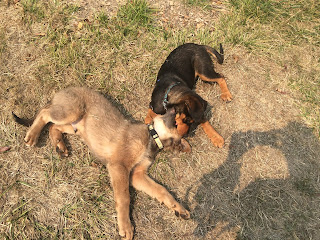 |
| Photo credit: Bailey & Banjo. |
This blog may end up in the "save it for therapy" category, but my heart is taking a beating today and I am compelled to write about it. You may want to have a tissue handy.
My dog Molly died nine years ago today. My very first dog, my best friend (and often solo companion) for over 13 years and the inspiration for my business and my life as I now know it, filled with dogs. Her death absolutely flattened me. Decimated me. Rendered me dysfunctional for the better part of a year. I lay in my bed and sobbed for at least two hours a day, every day. Sometimes twice a day. I burst into tears when the checker at the grocery store asked, "How are you today?" I stumbled through work, a zombie version of myself.
I was comforted by so many who knew her and loved her and, as they say, time does (eventually) heal all wounds. After nearly a decade, I've learned to compartmentalize my pain. But even something simple, such as a Facebook memory, can pull me right back under that all-encompassing wave of grief.
| Molly, the original sidekick. |
When Molly was around nine years old, along came a fellow named Foghorn Leghorn, who came to be known as Foggy to his friends. He was seven weeks old. When I got home that day, I held him in the palm of one hand while I opened the door to the house. He was supposed to be a short-term foster (hence the goofy “temporary” name), but you know how that can go...
From day one, Foggy was meant to be my dog, and I his person. I've often called Molly my "heart dog," but with Foggy I soon learned it was possible to love more than one dog with all of your heart. Hard to believe that fat-bellied little pup just turned 13. He’s now the same age Molly was when she left me.
Today was a perfect fall day: crisp, clear and my absolute favorite WA weather. I worked the first half of the day (with the dogs' help in most classes and lessons). After work, we romped in an empty field. I then spent one-on-one time with each of them: walking, sniffing, playing, training, more sniffing, sitting in the sun and simply enjoying each other’s unique company.
When we got home today, Foggy's back legs looked as bad as I've seen them, especially the left rear, despite a relatively easy day for him physically. For months I've suspected that he's got spinal stenosis or a growth in or near his spinal cord.* He's still sharp as a tack mentally, though deaf as a post. It seems he will follow in Molly's footsteps: a keen and intact mind with a body that can no longer keep up. A mile is a long walk for him these days, and I remember those days with Molly as well. It was such a shock when Green Lake (Seattle), a roughly three mile loop, became too far for her.
Every moment is a gift. Sometimes the days can feel so damn long, but the years are so damn short. I'm viscerally aware of Foggy's decline. I'm hereby throwing myself headlong into his/our bucket list. For now, we'll snuggle on the couch as we wind down for the night.
As far as the weeks to come, I absolutely dread the day. I'm not ready. I will never be ready. The thought of losing him...that day simply cannot ever arrive. It's something I've started to be so very conscious of despite my inability to comprehend it at all.
To all those who have loved and lost a beloved canine, I know you know. I hold you all in my heart, and I know you hold Foggy and me in yours.
*A request: please no advice re: medical or other treatments for Foggy. This ain't my first rodeo and I've got it handled. I will keep him happy and comfortable for as long as I can in the best ways I know how.



















